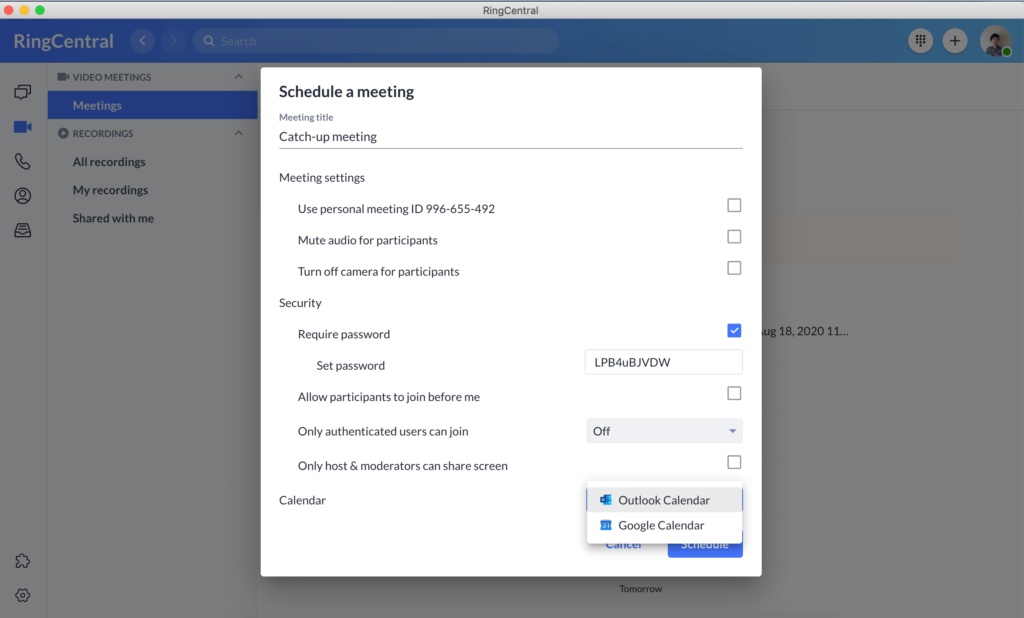Updated July 2021
It’s late, and your phone rings. You grab your cell phone, but realize it’s coming from your computer.
Who could that be?
You open your laptop and see a flashing box displaying a name… YOUR name. But how is that possible? How could I be calling myself? Unless…
The call is coming from inside the house!
You’ve read articles about popular conferencing software that were discovered to have serious insecurities, heard the stories of grandparents being scammed into sending money to a stranger, or, more recently, saw Twitter profiles of prominent figures getting hacked with promises of Bitcoin donations.
What these examples show is that a cyber attack can happen to anyone, anytime, on almost any platform. And when it comes to your business, you never want to open yourself to an attack, especially when you can protect it with something like a secure video conferencing solution.
Now, we’ve pretty much made it our life’s work as a company to build a video conferencing solution that’s multifunctional, designed for business use, and as secure as possible. And today, it’s more important than ever to share that knowledge. How can you keep your video meetings safe? How do you prevent strangers from randomly entering your meeting?
In this blog, we’ll tackle that and other things you should know about secure video conferencing too, including:
- Why it’s important to invest in a secure solution
- 4 things to look for when assessing your business’ needs
- Best practices to follow to keep your video conferences as secure as possible
- Which video conferencing software is most secure?
Learn more about video conferencing security. Download the free cheat sheet.
Why is it important to have a secure video conferencing solution?
We know what you might be thinking—it’s just video conferencing, what could they possibly get from my video?
But how many times have you shared documents while on a video conference call? What about just saying confidential information?
And saying “It’ll never happen to me,” pretty much guarantees that it will happen to you (and someone will be hovering over your shoulder saying, “I told you so”).
Think of a secure video conferencing solution as having locks on the door to your home. Even if you’ve never had an intruder, does that mean you don’t need locks?
Of course it doesn’t. It just means you’ve been lucky.
And with your company, not only is it your own information you may be compromising, you’re also risking every employee and anyone they have on their insurance—like a spouse or child or family member.
On top of that, if someone hacked into your account, they could do irreversible damage that could ruin your business, which is, obviously, terrible for you and your employees.
Yeah, it’s scary, and it sounds over-the-top and ridiculous, but it happens. In fact, 60% of small businesses that are hacked go bankrupt in six months..1
Lastly, you want to keep your business secure to keep your client’s trust. In recent months, you’ve probably had numerous video meetings with your clients. Maybe you talked about financials or budgets, or maybe you talked about upcoming projects that aren’t yet ready for public view.
If this information were to be made public, it could cost the client a lot of money—and it would probably cost you the relationship, too.
4 things to look for in a secure video conferencing software
We’re confident you already know there are a lot of options out there for video conferencing solutions. To cut down the list of potentials, we’ve compiled five things to look out for when choosing the best secure video conferencing software:
- A video conferencing solution made for businesses (not for calling up your friends or family on the other side of the world)
- Software that defaults to enabling security features
- Software that regularly updates
- Options to control your meeting security features
1. A video conferencing solution made for businesses
This is, by far, the most important thing to look for in a secure solution. For the people in the back row, this is the most important thing to look for in a secure solution.
You’ve probably video chatted many times before—caught up with family, played some virtual board games with friends, got a tarot reading while eating a cinnamon bun—so you know what you want, and you’re pretty much an expert.
Except those video conferencing companies may not have the sophisticated security features that are necessary for running a business.
Do you know who does have the security features you need? Ring. 👏 Central. 👏
We have a global team of cybersecurity experts who are involved in every aspect of the platform, implementing features bound to make your IT team happy:
- Secure software development
- Strong access controls
- Resilient services
- Threat detection and mitigation
- Service operations controls
- Customer admin and user controls
- Built-in support for regulatory requirements
- Secure application programming interfaces (APIs)
- Pre-built integrations
- Transparency
That’s because our product is made for businesses—and specifically designed to maximize your ability to collaborate, streamline processes, and connect with colleagues and customers from all over the world.
2. Software that defaults to enabling security features
You definitely want to look for a product that enables all (or, at least, the most important) of its security features. This is because of two reasons: If you don’t know it’s there, how will you know to turn it on? Secondly, if you have to turn everything on manually, the protection is now in all of your employees’ hands—and even though they may mean well, humans can forget or miss things.
3. Software that regularly updates
We get full shifty eyes when we see a developer hasn’t updated their product in years. No app, software, or program is perfect, and a company should always be updating their product. If they aren’t, they have either moved on from that product (maybe onto something better) or the company is defunct.
Quickly check their update log—how often are they updating? What are they updating? It’s also not a bad idea to look at reviews, too. See if anyone comments on their customer support, if their updates are helpful/hurtful to the product, and if the company responds to reviews.
4. Options to control your meeting security features
In addition to having control over your app’s overall security features, you want to look for solutions that have options for when you are in an actual meeting.
If someone is there you don’t want to be (or don’t know), you should be able to remove them from the meeting. If you noticed a team member didn’t put a password on a meeting—especially if it’s confidential!—you should be able to implement one even if you weren’t the meeting host.
There are plenty of other options, so make sure that whatever you choose gives you an overabundance of control.
5 secure video conferencing best practices for businesses to keep their information locked down
Okay, you’ve found the software you love, and you’ve gone through all the security features you want, and you feel good about having a safe and secure meeting. Before you sit back and think you are covered, there are very simple practices you can introduce into your process to make your meetings that much more safe:
- Password protect your meeting
- Don’t automatically give participants the ability to screen share
- Lock the meetings
- Check the security settings for every meeting
- Make a company policy about security
1. Password protect your meeting
Protect every meeting with a password, every time. Bonus points if there’s an option to require every user to use a password if they’re scheduling a meeting. You could just be catching up with Joe from Design to chat about a great new campaign he’s designing, but then he brings up open rates for a previous email, cost-per-click for the most recent ad that launched on Facebook, or he decides he wants to talk to you about a raise (Joe really wants to redo his bathroom, we get it).
You never know what could come up in a meeting, so make sure you’re always prepared.
For example, you can launch a video meeting right from RingCentral’s app—and the password protection feature is turned on by default. (Along with a pretty difficult password that’s automatically generated!)
2. Don’t automatically give participants the ability to screen share
This is an easy one to overlook, but there have been many instances of hackers getting into a video meeting, taking over the screen, and posting incredibly offensive stuff for all participants to see. Easy way to avoid this is to change the default screen-sharing option to only approved people or no one at all.
3. Lock your meetings
Like password protection, you should lock every meeting after everyone you have invited has joined. This will prevent any random people from joining and potentially causing a disruption. Here’s how it looks in a RingCentral Video meeting:

If you have larger meetings where you may not know everyone or know how many people are supposed to join, lock the meeting a few minutes after the start time—just make sure you communicate to everyone that you will be locking the meeting, and they won’t be able to join after.
4. Check the security settings for every meeting
It’s easy to get into a routine and forget to implement certain security measures, but try to make it a habit that you check and recheck the security settings for every meeting. Your future self will thank you.
5. Have a company policy about security
Even if you decide to only let your IT have admin rights and everyone else is a regular user, you should communicate the importance of security. Create a company doc with a security checklist that an employee can reference every time they schedule a meeting, or allow a few senior employees admin rights and make sure at least one is on every meeting to make sure everything is set up correctly.
🕹️ Get a hands-on look at how RingCentral works by booking a product tour:
💰 You can also use this calculator to see roughly how much your business could save by using RingCentral to support your team’s communication with each other—and clients.
So…which video conferencing software is the most secure?
There are lots of options out there for video conferencing—many of them advertised as customer-first, always putting privacy and security above all else. Then you read reports of people finding insecurities in the code that allows the app to turn on the camera without informing the user. Or that a company has background access to a user’s data like texts, emails, and photos.
As we mentioned above, our number one tip is to only look for solutions that are made for businesses. Their security and dedication to clients will be miles above any other video conferencing solution because they know the importance of confidentiality for a business.
Still, you have options, which you may see as a benefit or disadvantage, depending on how much effort you want to put into finding the best solution. What we can tell you is why you should consider RingCentral first.
Why RingCentral should be your go-to video conferencing solution:
- It’s made for small businesses
- It works across operating systems and devices
- You have access to a customer service team who can answer all your questions
- It’s easy to pick up and use
It’s made for small businesses
Beyond our dedication to privacy and security, we’ve designed RingCentral to be an affordable solution, especially for small businesses.
You shouldn’t have to pay an outrageous amount for the best features to make sure your company is safe, secure, and operating efficiently. RingCentral offers various plans with a wide range of features, so you can get exactly what you need at a reasonable price, like unlimited 1:1 meetings, group meetings up to 100 participants, screen and file sharing, team messaging, calendar integrations, and multi-platform syncing—all for a low per user per month fee:
It works across operating systems and devices
No matter what device you work from—phone, tablet, laptop, or desktop—whenever you need to hop on calls, schedule meetings, or shoot quick messages out to your team, you can do it all with our easy-to-use and secure mobile and desktop app.
You have ready access to a customer service team who can answer all your questions
We have offices all over the world, in the US, UK, France, China, Philippines, and Australia. Our team is always available, no matter which time zone, to help you out.
Our customer service team is with you from the moment you engage with us and on. There are specially dedicated teams at all stages of your onboarding, and you work with an assigned technical account manager and an assigned customer success manager to help you with anything you need (like setting up your security protocols).
It’s easy to pick up and use
Simply, our video conferencing software is intuitive and easy to use. You’ll be ready to start a meeting in minutes—even if you’ve never been on a virtual meeting before in your life. And, best of all, your meetings are safe and secure using RingCentral, so you can focus on running your business and leading your team.
Here’s to safe and secure video conferencing for your business
So, now you know all the reasons why you should keep your company protected, and we hope you learned some basic tips for keeping your meetings safe. If you still have questions or want to learn more about what you can do to keep your company secure through video meetings, reach out to us—we’re always happy to help.
1inc.com/joe-galvin/60-percent-of-small-businesses-fold-within-6-months-of-a-cyber-attack-heres-how-to-protect-yourself.html
Originally published Jul 01, 2020, updated Jul 23, 2024






